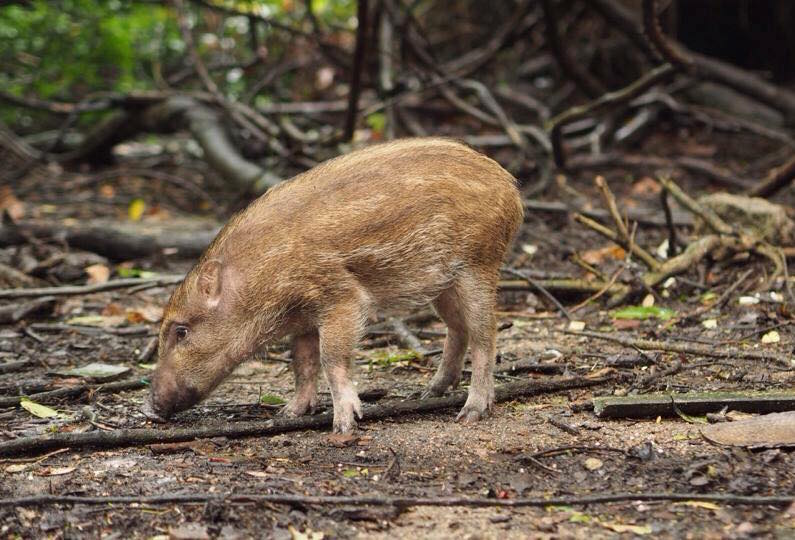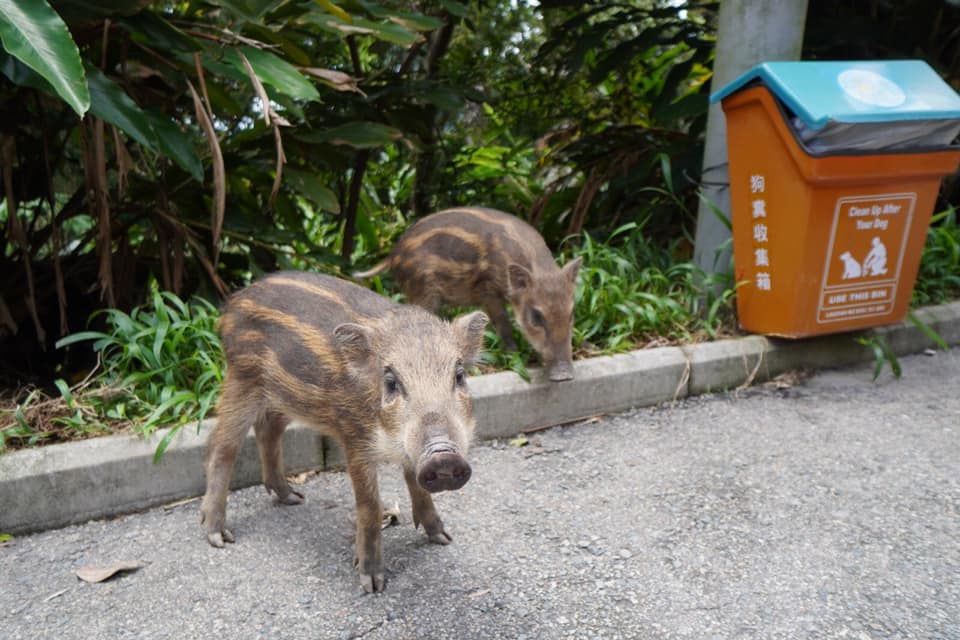By Anthony Lau and Evan Pickett
The Agriculture, Fisheries and Conservation Department (AFCD) recently announced that they will resume culling as an option to manage the city’s worsening conflicts between city dwellers and wild boars.

Under this new direction, wild boars causing nuisance in urban areas may be captured and euthanized directly, as opposed to being relocated to country areas. This has led to widespread backlash from animal rights groups, netizens, and environmental NGOs, citing the decision to resume culling as inhumane, irrational, and ill-advised.
Some even see it as a direct response to a recent incident in which a police officer was injured by a wild boar.
The wild boar is a native generalist, which means it can survive in a variety of habitats and has a wide-ranging diet. Local ecologists suspect the wild boar population in Hong Kong has increased steadily in recent years.
This suspected increase can be attributed to a few factors: overall improvement of its primary habitat, a lack of predators, and additional food from garbage and well-intentioned animal lovers.
In the past several decades, the vegetation cover in Hong Kong has slowly recovered owing largely to the government’s effort to protect and restore Hong Kong’s forests and the associated watersheds in order to prevent landslides.

Over 40 per cent of the city’s territory is protected under the country park system, deforestation has ceased for the most part, and hunting of most wild animals has been outlawed. These efforts have benefited a variety of wildlife, including wild boars, which rely on these forests to survive.
In theory, wildlife population growth is not infinite and is regulated by carrying capacity. Historically and ecologically, boar populations were controlled via predation from native fauna and hunting from humans. However, large predators such as leopards and tigers were hunted to extinction in the last century, and more recently (in 2019) the AFCD decommissioned a boar-hunting programme that permitted licensed hunters to remove nuisance boars.
This means there are no longer any native predators capable of taking down full-grown wild boars. On the other hand, as boars mature and leave their mothers, they disperse into the surrounding environment. Once the population is large enough, the boars on the edge of the forest will inevitably move into the city, which has resulted in boars being spotted in the MTR and hikers being knocked over by aggressive/curious boars.
This problem is not unique to Hong Kong. Singapore is experiencing a very similar problem: an increasing number of human-wild boar conflicts owing to urban encroachment and illegal feeding. Recently, a wild boar was captured and euthanized following multiple incidents involving aggressive behaviour.

Over the years, the AFCD has experimented with a number of approaches to managing the increasing wild boar population in Hong Kong. For example, they have worked with the Food and Environmental Hygiene Department to deploy boar-proof garbage cans in various locations to minimize or deter dumpster-diving boars.
They have introduced a translocation and contraception programme in order to either relocate nuisance boars or neuter adult boars in the hope that the population can be reduced to a level that limits boar attacks without threatening the long-term viability of their population. They have also commissioned local NGOs to conduct “Don’t Feed Wildlife” educational campaigns to dissuade the public from feeding.
Despite millions of taxpayers dollars spent on research and counter measures to manage the boar population, the results have been underwhelming. While the number of infertile individuals has increased steadily, sightings of boars in the city have increased even faster.
Animal feeding has not ceased and successful prosecutions of offenders are few and far between. Complaints about boars and boar related injuries are also at a record high. It is clear that these measures alone are not effective in managing the problem of nuisance wild boars, and that is why culling should be an option available to the department for nuisance pigs that are proven to be dangerous.
So what exactly is culling?
Culling, simply put, aims to selectively (as opposed to randomly) remove nuisance wildlife around sites of anticipated conflict under the assumption that reducing populations will reduce conflicts. It is an effective and widely used method to control nuisance or invasive wildlife, contain wildlife disease, and manage wildlife habitat.
For example, in the United Kingdom, culling was used as a primary means to remove European badgers to avoid transmission of tuberculosis to cattle. Culling is also the main method used to manage a surplus of large wild animals in parts of Europe and Japan where hunting is banned or heavily restricted.
Research in Japan suggested that culling could reduce the boldness of urban deer and consequently prevent future conflicts. In Hong Kong, the AFCD may consider only removing individuals that are showing clear signs of habituation and boldness.
Why can’t we just leave them alone?
One might ask why should we bother with managing a native species? Why can’t we just leave them alone? Indeed, the wild boar is a part of our natural heritage and has every intrinsic right to be here. They are also excellent photo ops for a city otherwise known as a concrete jungle.
However, their ever increasing presence in both country and urban areas might mean more harm to our society and ecosystem as a whole. In the countryside, their increasing presence and propensity to uproot young plants in order to obtain food has caused soil erosion and likely affected recruitment of native plants.
The fact that they are more frequently observed in broad daylight in urban districts is also a sign that they are getting accustomed to city life and becoming more dependent on food from humans.
Wild boars can be aggressive when provoked, especially when they are with their young or if trapped in an unfamiliar environment. Boars that are accustomed to being fed are also more likely to be aggressive towards humans.
More alarmingly, it is almost certain that animal feeding, given enough time, could introduce foreign pathogens, such as the one responsible for the African swine flu, into our native boar population.

Recently, a dead wild boar found in Siu Sai Wan tested positive for the African swine flu. Siu Sai Wan is only a stone’s throw from Shek O Country Park, which is one of many “feeding hot spots” throughout the city where animal feeders are spotted regularly with bushels full of nutritious “offerings,” which may be contaminated with pathogens.
As conservation biologists and academics trained in population ecology and wildlife management, we support the AFCD to continue their adaptive, science-based, and holistic approach to managing the city’s wild boar population. There is no silver bullet in wildlife population management. The heart of the problem is how to strike a balance between public safety, animal welfare and conservation.
What can you do to help alleviate human-wild boar conflict? Never under any circumstances approach or feed wild boars when you spot them. Manage your edible waste better and only dump your edible garbage in boar-proof garbage cans. Report suspected animal feeders to the authorities by calling the government hotline (1823).
Anthony Lau is a research assistant professor in the Science Unit of Lingnan University, with research interests in population ecology and wildlife management. Evan Pickett is a lecturer in the University of Hong Kong Faculty of Science, teaching mathematics, statistics and biology.
Support HKFP | Policies & Ethics | Error/typo? | Contact Us | Newsletter | Transparency & Annual Report | Apps
Help safeguard press freedom & keep HKFP free for all readers by supporting our team
| HKFP is an impartial platform & does not necessarily share the views of opinion writers or advertisers. HKFP presents a diversity of views & regularly invites figures across the political spectrum to write for us. Press freedom is guaranteed under the Basic Law, security law, Bill of Rights and Chinese constitution. Opinion pieces aim to point out errors or defects in the government, law or policies, or aim to suggest ideas or alterations via legal means without an intention of hatred, discontent or hostility against the authorities or other communities. |

More HKFP OPINION:
HKFP has an impartial stance, transparent funding, and balanced coverage guided by an Ethics Code and Corrections Policy.
Support press freedom & help us surpass 1,000 monthly Patrons: 100% independent, governed by an ethics code & not-for-profit.











